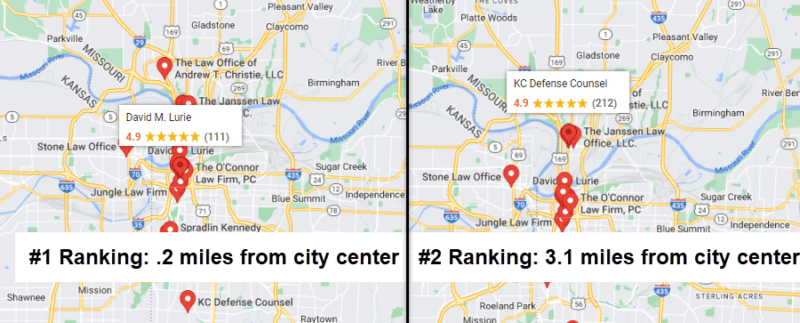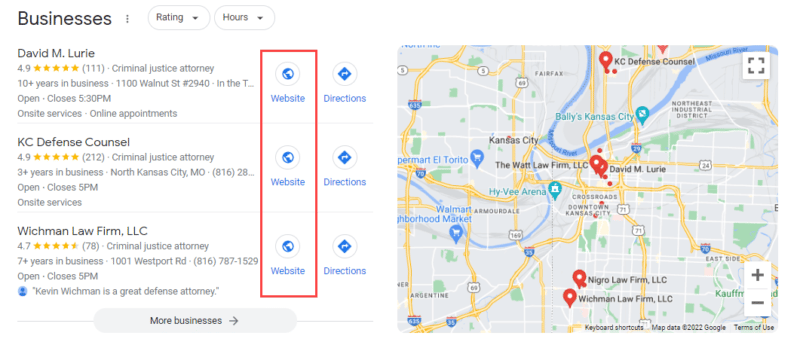When it comes to local SEO, there’s a lot of noise.
From the latest industry buzz talk to the nuances of a specific website, a strategy to-do list can quickly become flooded with tasks that don’t consider the big picture.
However, none of these tasks matter if you ignore competitors.
A competitive analysis for local SEO can uncover:
- Who is ranking at the top.
- Why they achieved this ranking.
- Where they’ve chosen to target their strategy.
- What level of effort they’ve put into ranking.
- When you might be able to outrank them.
If you understand the effort and approach used by those who rank well locally, then you can thrive in even the most competitive search environments.
Determining your local competitors
Competitors in local SEO require a different approach than competitors in national markets.
In a national SEO campaign, competitors are usually targeting hundreds or thousands of keywords. At the local level, most competitors typically target something in the range of 20-100 keywords.
Local SEO typically has fewer keywords because it is defined by its physical community.
Local SEO is designed to support a network of small businesses, franchises and physical goods and services. Unlike national SEO, there is no SaaS or cloud-based architecture or leading national ecommerce website.
Local dealers, practitioners and businesses offer a service or item that customers will receive in their community. Products and services from these businesses are limited to the parameters of their local population. If a local business offers garage door repair, demand is limited to the number of people who need garage door repair in that community.
Because local SEO is limited to a physical community, discovering competitors is straightforward. Identify 5-10 core keywords and see who ranks first.
However, competitive analysis for local SEO quickly becomes complicated when there is more than one location for the business. Each location poses unique challenges.
Although local competitive analysis considers a smaller portion of keywords, the complexities of local search impact these keywords.
3 steps to conducting a competitive analysis for local SEO
A competitive analysis for local SEO considers keyword search visibility in the context of three local ranking factors:
- Compare proximity.
- Assess Google Business Profile (GBP) optimization.
- Analyze on-page content.
1. Compare proximity
Are you located farther from the city center than your top competitors? Does this information about your location even matter? After all, it’s not like you can move locations for the sake of SEO.
Understanding your location within the context of your competitor’s location is important because proximity might answer why they rank #1.
In the image below, a search for “kansas city defense attorney,” a highly desirable keyword for defense attorneys in Kansas City, the #1 ranking is held by a law firm that is located .2 miles from the city center of Kansas City. The #2 ranking business is located 3.1 miles from the city center.

A quick search for your top keyword can indicate whether proximity will impact your campaign. Review the distance between verified location and city center for the #1 ranking GBP (a.k.a., your competitor) in the Local Pack. Then, compare your competitor’s distance to the distance between your verified location and the city center.
If you’re a Service Area Business (SAB), then your competitors are also likely SABs, which means you won’t be able to check the distance between their address and the city center. In these scenarios, you should still note the distance between your verified location and the city center.
If your website struggles to achieve local ranking growth in the future, proximity could be limiting progress. Sometimes your verified address will be too far from the target location to rank, which means you may need to change your target location.
During a competitive analysis for local SEO, a quick check of competitor proximity is sufficient to understand how much distance matters in your specific marketplace. However, you may determine from this initial check that a deeper understanding of your proximity would help frame your strategy.
If a more comprehensive analysis of proximity would help, consider completing a full proximity audit as a next step. For example, you might consider a full proximity audit if you look at distance, GBP, and on-page strategy but still can’t determine why a competitor ranks well. The proximity audit is a deeper analysis of all the factors that impact proximity-based rankings in a specific marketplace.
2. Assess GBP optimization
In local SEO, Google Business Profile is the star of the show. Everyone is vying for that #1-3 position in the Local Pack. Competitors typically pay the most attention to GBP with their local SEO strategy because this profile appears directly at the top of search results.
Assess the following ranking factors across your competitors’ GBP listings and compare your own profile:
- Name
- Primary category
- Other categories
- Reviews
The name, primary category and reviews are directly visible on the profile, but viewing a business’ additional GBP categories will require a tool like GMB Everywhere. Those are the key ranking factors on Google Business Profile, but it’s also important to look at how much competitors have invested in additional GBP features:
- Description
- Photos
- Questions and answers
- Products
- Services
- Posts
If competitors are ranking solely due to reviews and proximity, then a few adjustments to your GBP categories might improve your Local Pack rankings. But if a #1 ranking competitor has fleshed out their profile with every detail and they are posting every week, then it will likely require substantial effort to outrank them.
Ultimately, a Google Business Profile is intended to update users with as much information about the business as possible. Rankings are great, but keeping customers informed about your business is a solid practice across all communication channels.
3. Analyze on-page content
On-page SEO is an important ranking signal for the Local Pack. So, what does that #1 ranking competitor’s website look like? Click the Website button featured directly in the Local Pack to get started.

While analyzing competitor websites, you’ll typically see two types of sites linked from GBP:
- Homepage for a single location business.
- Location page for multi-location business.
Content on a homepage is often structured differently than content on a location page:
| Homepage | Location Page |
| Service pages in nav | All services listed on the page |
| High-level business information | Location-specific information |
| High volume of backlinks | Typically fewer backlinks |
| Original content | Content might be duplicate between locations |
Review your competitor’s homepage or location page to determine how much effort is needed with your website. How much has your competitor invested into their website and/or their location page?
Here are some questions to review for either a homepage or a location page linked from GBP.
Homepage questions:
- Are there a lot of service pages in the navigation?
- Does the website appear modern/mobile-friendly?
- Does the website feature awards, testimonials, or customer reviews?
- Does the website use optimized title tags?
- Does the homepage feature video, Q&A, or other standalone content?
Location page questions:
- Does the location page discuss local services?
- Is the content original to that location page?
- Is there a CTA that users can easily view and interact with?
- Does the location page use optimized title tags?
- How does the rest of the website link to this location page?
- Does the page include content from local providers (video, bios, etc)?
These questions are by no means exhaustive, but they’re a good starting point and can help you understand the level of investment and strategy behind a competitor’s website.
Compiling the information and looking at the big picture
You’ve gathered information about a competitor’s proximity, GBP and website. Now, it’s time to analyze this information and ideate your local SEO strategy.
Here’s an example of what we could learn about a #1 ranking competitor for “houston dentist.”
| #1 Ranking Competitor | Our Location |
| .5 miles from city center | 2 miles from city center |
| 812 reviews on GBP | 435 reviews on GBP |
| Primary category: Dentist | Primary category: Cosmetic dentist |
| Posts weekly on GBP | Posts occasionally on GBP |
| GBP links to homepage | GBP links to location page |
| Homepage includes video content | No video content on location page |
| 15 service pages | Location page mentions 2 services |
In the above example of competitive analysis for local SEO, we can see that our business needs several improvements to compete for that #1 ranking, from updating the GBP category to considering video content.
The best local SEO strategy is unique to its marketplace
That marketplace includes competitors who have invested a varying amount of content optimization, linking, and even physical real estate. While there will always be an SEO to-do list, a competitor analysis can help determine which tasks will make the biggest impact.
The post How to do a competitive analysis for local SEO appeared first on Search Engine Land.
No comments:
Post a Comment